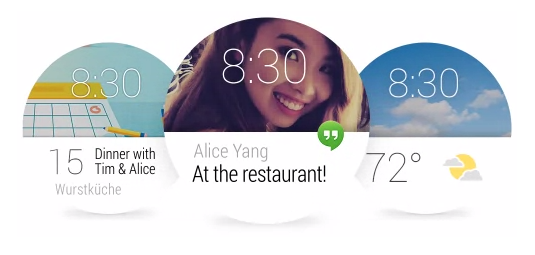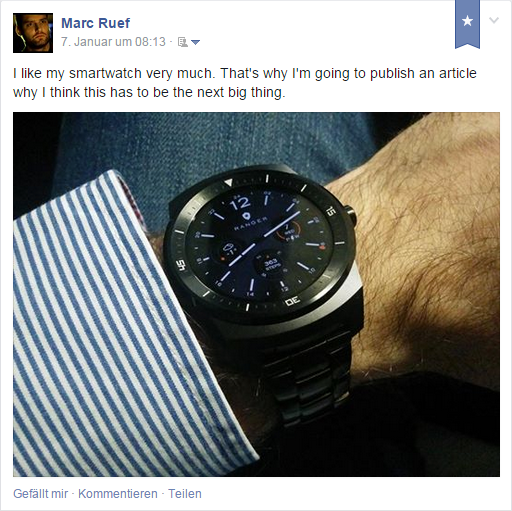Specific Criticism of CVSS4
Marc Ruef

In the field of information technology, there’s something new every few years. Something that everyone involved in the field talks about. However, few of these things end up actually being something tangible. Following on the heels of Web 2.0 there was Virtualisation and Cloud Computing. Only after many years the marketing mess untangled itself and made way for a sober and realistic understanding of the new possibilities and risks.
Currently, wearable computers are that topic. They have been a hot topic of discussion for about a year now. But there have been hardly any reports of long time use and experiences made during that use. That’s why I want to document my personal impressions during the first few weeks of using a Smartwatch. I will not only go into the technological aspects but also into the sociocultural ones, that is intrinsically connected to the latest generation of networked gadgets.
Wikipedia defines Wearables as computers that can be worn underneath or on your clothing. In the 1990s, LED based wristwatches were a fad. Users could play with a built-in calculator, store small amounts of data and play what we would consider to be primitive games today. Going with the definition, those were the first Wearables.
Today’s Smartwatches follow this principle. There are manufacturer who have pushed into the market with these products. Fitness trackers like the ones by manufacturers Fitbit and Garmin belong into that category in its broadest scope. Narrowing that scope a bit and getting closer to the Smartwatch, there’s Samsung’s Gear series. In the near future, there will be the ZenWatch by Asus and the long-awaited Apple Watch. Experimental features promise the following: or Montblanc and other luxury watch makers, they are taking charge by offering what they feel is the ultimate combo – a traditional mechanical luxury watch with a strap that contains a smart wearable device and the E-Ink displays of the Lenovo Vibe Band.
Looking at the functionality and the build, these two devices are quite similar. In this article, I will talk more about the basic concept of a Smartwatch rather than the diverse implementation and their individual kinks. Personally, I use a LG G Watch R (W110) that was released in September 2014. Together with the Moto 360, it’s one of the the best round smartwatches. The watch cost 259 CHF (312 USD on Amazon) and I replaced the leather wristband it came with one made of steel.
While I won’t be going into alternative wearables such as Google Glass, the insight in this article can be applied to other types of wearables. Of course, there will be differences in the hardware and software based haptics.

Like with every new technology, there are sceptics who deny that a Smartwatch has any use. The basic claim is usually that we managed fine without a Smartwatch thus far and therefore can go on without one. Be that as it may, stasis is not something anyone should actively strife for.
The critics are quick to retort: A Smartwatch needs constant charging. And old watches powered mechanically or by battery were much better. I think this is comparing apples to pears as the German saying goes when talking about two things that are fundamentally different and find themselves being compared nonetheless. Another example: I don’t have to fuel up my bicycle. Ever. But that doesn’t mean it’s better than a car in any and all criteria. Looking at Smartwatches, the deciding factor whether or not it’s a useful gadget to have is the one that asks for the user’s specific and individual goals and needs.
Current Smartwatches are thought of as companion devices. They are not autarkic and autonomous devices but as an extension of a smartphone that already exists in the environment in which the smartwatch is to be used. Android devices need to have the Android Wear App installed in order to communicate with the smartwatch using Bluetooth. The devices synchronize data primarily. Android Wear is, in that case, more of a remote access tool, comparable to X11, RDP or Citrix. Today’s smartwatches are also called second screen devices.

When connecting the Smartwatch to the Smartphone, the watch reads the current configuration and transfers the latest notifications. They can subsequently be edited on the watch. What was important to me was that I didn’t have to deal with the notification for the second time on my phone. Basically, when I mark a notification as read, I want it to be marked as read on my phone as well. In Android Wear, the communication is bidirectional, as opposed to products by Garmin that function only as a notification element.
The name Smartwatch is therefore rather badly chosen. It implies that it is primarily a watch that can do computer based things at the same time. However, it is rather a small computer that also shows the time. If you take into account this completely different view on the issue, the direct comparison between classic watches and Smartwatches can’t be made. Apples and pears, you see.
Some say that wearing a watch became superfluous with the establishment of smartphones in our society. The reason: Smartphones also show the time. The people purporting this argument imply that, following that logic, smartphones don’t have any kind of raison d’être. I want to flip that argument. Since I have my Smartwatch, I use my mobile phone very, very rarely. I use it for an odd message here and there that I want to type and not speak out loud. And of course for phone calls. In average, I take my phone out of my pocket two or three times. Before the smartwatch, it was 20 to 30 times. This is a gain in both comfort and efficiency that is quite respectable. I just feel that much at liberty.
Critics mock the short battery life of a Smartwatch. My LG G Watch R lasts two or three days on a single charge. At home I don’t wear the watch and I charge the watch over night which occasionally makes the watch last four days. I charge my phone every night. Charging a watch every other night is a tiny bit of additional effort but is totally insignificant in view of the gain in efficiency during use.
Charging the Smartwatch takes about 45 minutes. This seems very fast when comparing it to the charging time of a tablet of a smartphone. In case of emergency, I could charge my watch over the course of my lunch break. Charging is done using the charging dock that comes with the watch. It’s about the size of the watch itself and is plugged into a MicroUSB adapter. I would have been very happy if there had been a USB port on the watch itself or at least the possibility of wireless charging (Moto 360 offers Qi). However, the current solution is practicable enough to not be a bother.
Using Android Wear, several factors have an influence on the battery life of the device:
Targeted optimizations allow for the watch to be charged every third night. This is a sensational result considering the size of the battery in the device.
I am very active online. I run websites, get a lot of e-mail and I use social media as well as a plethora of chat systems. This results in there being many notifications. This flood of notifications steadily moved away from e-mail in the past few years and has become a more fragmented and more frequented activity. If I am involved in an interesting discussion on Twitter, it can happen that I get notifications from Twitter every minute. The constant noise or buzzing of my phone makes it impossible to focus on anything but.
By using a smartwatch, I had hoped to change my habits of use. I had two goals
It often happens that my smartphone vibrates, because someone liked my status on Facebook. But, seriously, this is something of very little importance, but you only notice that it’s this important little thing after interrupting your current task and checking the phone.
Even before I switched from iOS to Android, I was very intent to reduce my notifications to the most important ones. On my Nexus 5, I am able to use Light Flow to tone down the volume of notifications. I was able to improve on this using my smartwatch.

The smartwatch is able to suppress notifications by certain apps. At first I left all notifications the way they were on both devices. But it quickly became irritating that my watch and my phone vibrated more or less at the same time. Android Wear offers to completely mute the Smartphone it’s tethered to. Notifications are therefore only displayed on the smartwatch. This is what I did after a few days.
I am still being interrupted by notifications, but it happens in a very reduced form and feels strangely natural. The device on my wrist vibrates and I know: Something’s going on. When I have time, I check it out. I notice a weird trend with this: It is a lot easier to ignore a notification on my watch for several hours completely. On my phone, I had the incessant urge to check the notification immediately. I have no idea what the psychological reason behind this strange behaviour is, but I’m glad that I was able to overcome this strange urge.
The intelligent processes that come with the use of a smartwatch are highly individual and not societally established:
Google has, after an update of Android Wear, implemented a change in the display of cards. In version 1.0.2.1476973 users could pick if they wanted cards to be displayed in ambient mode. However, in version 1.0.2.1534065 the setting whether or not to display a card is always for both ambient mode and active mode. This, of course, made a lot of users unhappy due to the fact that they had to adjust their use of the device. The ideal solution hasn’t been found, though. I hope that Apple with their efforts towards simplicity and ergonomics will add new input here.
My smartwatch is seen as a companion device. This means that it’s an extension of the phone and has to rely on the functionality of the phone.
Still, the developers have made efforts to make the device work without a phone present. The watch face keeps being on screen. And by clever synchronizing of data it has become possible that certain activities are still possible. Due to caching, all transmitted notifications can be displayed and managed. But the actual activity that you performed such as deleting an e-mail happens only after reconnecting the watch to the phone.
Android Wear informs the wearer of the smartwatch with a small icon on the watch face that the connection to the smartphone has been lost. If a user leaves his phone, he or she will only notice it after about 10 to 20 meters when the Bluetooth connection aborts. There are Wear apps that trigger an alert when that happens. Find my Phone and Wear Aware have the additional feature that they can make the phone ring when the connection fails.
Unfortunately, a smartwatch can only be paired with one smartphone. But one phone can be paired with several watches. There is BeeLink that retrofits this feature into Wear. However, it doesn’t appear to still be offered in Google’s Play Store. I hope that one day, pairing a watch with several devices will be possible in order to create a seamless net of pairable devices across several rooms using tablets and smartphones as tethers. It’s a reasonable assumption that this will be possible in future generations of the device.
Android Wear paired with Android 5 offers the use of Smart Lock on the phone. Using it, there’s no need for a PIN or a password on the phone when the devices are paired. If the connection between the devices fails, Smart Lock gets disabled so that nobody can tamper with a phone lying around.
Android Wear uses Bluetooth to connect smartphone and smartwatch. This means that there’s an additional wireless communication that can be attacked by third parties. Bluetooth keeps gaining ground and appears to have gotten more upwind with the invention of Bluetooth Low Energy. The risks that come with this is something users need to be aware of. It’s not new, but it becomes permanent with the use of a smartwatch.
A software based attack on the smartwatch is rather uninteresting seeing as the device is just an extension of the smartphone. Accesses are being passed on indirectly and piped through a smartphone. This is true for apps, notifications as well as watch faces.
The presence of a smartwatch makes the installation of additional services on the smartphone necessary. This broadens the attack surface. But the apps for Wear are smaller than those for smartphones. Sometimes, functionality on Wear is introduced by a phone app (such as Gmail, Keep or Fit). If you run a lot of apps on your phone, the Wear apps will only marginally heighten the risk for attack.
With Google Glass the derogatory term Glasshole has found its way into popular culture. The wearer of Glass are being called impolite by it because they have the ability to record the people they look at without their knowledge. With smartwatches, the same can be done for audio. In high security environments, smartwatches will be frowned upon.
Smartwatches can become a risk in traffic. It’s been established that nobody should use their smartphone while driving. But the fact that the same risk occurs with the use of a smartwatch is not that obvious. After all, it’s just a watch. Both users and lawmakers will have to get used to the new situation.
I’ve been wearing mechanical watches for several years and I saw them as functional jewellery. I was a big sceptic when it came to smartwatches. This scepticism went away after a few hours when I realized the potential in these small devices.
By extending the smartphone that people carry on them anyways, an unheard of comfort is achieved. It’s something that persists through everyday life. After about two days, I knew that I probably won’t ditch my smartwatch in the near future. On Facebook, I proclaimed it as The Next Big Thing.

Just like my first tablet changed my behaviour significantly, the smartwatch changes it again. My processes, how I manage messages, have changed massively. All the changes have been positive. In the coming weeks, I am certain that I’ll have much more fun with the device. And of course, I’m curious to see what the future will bring for both Smartwatches and other wearables. This market has not been explored completely and the technological possibilities have not all been exploited yet.
Our experts will get in contact with you!

Marc Ruef

Marc Ruef

Marc Ruef

Marc Ruef
Our experts will get in contact with you!